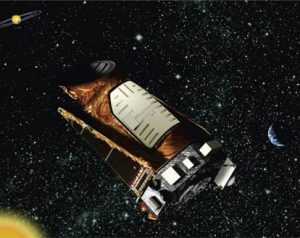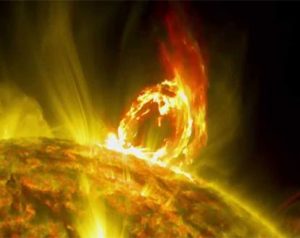A team of computer security experts from Ben-Gurion University in Israel have discovered 2G mobile phones could hack air-gapped computers and steal data via radio frequency wireless electromagnetic waves and a GSM network. In order for this process to work properly, both the 2G phone and the targeted computer must have malware installed on them. “Computers naturally emit … [Read more...]
Robots to Help Build Radio Telescope for Far Side of Moon
Researchers are making progress in building a radio telescope array that would be placed on the far side of the moon by a robot. The robot, or rover, would be controlled by NASA astronauts in the Orion spacecraft. A team at the University of Colorado Boulder, lead by Jack Burns of the Lunar University Network for Astrophysics Research (LUNAR), has developed a system that … [Read more...]
Testing Reveals Microwaves May Launch Aircraft into Space
A team of researchers from Escape Dynamics in Colorado have announced test results indicate microwaves might be able to launch space planes into space, which would allow for a single stage spacecraft. If this idea works, it would significantly reduce costs, because sending satellites and humans into orbit is typically very expensive. “Today's rockets are all based on the same … [Read more...]
Stephen Hawking Project Questions Why Earth has No Communication with Extraterrestrial Life
Stephen Hawking recently discussed his new 100 million dollar project aimed at discovering extraterrestrial life (aliens), titled “Breakthrough Listen.” Frank Drake, chairman emeritus of the Search for Extraterrestrial Intelligence Institute, produced an equation in 1961 for calculating the amount of alien civilizations capable of communication with humans. When Drake plugs … [Read more...]
Study Reveals Radiation from Solar Events Unlikely to Affect Earth
“In recent years, research has suggested congenital birth defects down on Earth's surface could be caused by these ‘solar particle events’ - spikes in cosmic rays from the sun that touch off the northern lights and sometimes hamper communications or the electric power grid,” according to Science Daily. Even though airplane crews at high altitudes are exposed to harmful levels … [Read more...]
NASA Captures Four-hour Solar Flare on Video
NASA’s Solar Dynamics Observatory (SDO) captured a solar flare and a coronal mass ejection (CME) on video on June 18. “The SDO has been studying the Sun since 2010 and captured this flare at multiple wavelengths, allowing it to show the ultraviolet light of the massive flare,” according to Mirror Online. The solar flare, which has been named “Spit of Satan,” lasted for four … [Read more...]
High Frequency Waveguide Couplers Operate to 110 GHz
Pasternack introduces a new portfolio of ultra-high frequency directional waveguide couplers that operate up to 110 GHz. The portfolio includes 28 unique coupler models with varying frequency ranges from 18 GHz to 110 GHz in frequency bands K, Ka, Q, V, E and W. Two physical configurations are available: the standard waveguide and split block waveguide. “Both the traditional … [Read more...]
Stand-alone Test Generator Recognizes EUT Power Configurations
EM Test introduces a multifunctional and compact test generator, the compact NX5. The NX5 meets “international and product-specific transient and power fail requirements, including EFT/burst to 5.5 kV, surge to 5.0 kV and power fail testing,” according to the company. It is also the first generator to recognize connect EUT power configurations. The NX5 offers advanced safety … [Read more...]
Astronomers Unveil View of Galaxy’s Electromagnetic Loop
This week at the National Astronomy Meeting (NAM 2015) in Wales, scientists working with the Planck Satellite, including Mike Peel and Paddy Leahy, revealed a new polarization map of the Milky Way in microwaves. This particular view of the electromagnetic loop discovered more than half of a century ago, has never been seen before. “It’s a full sky map showing synchrotron loops … [Read more...]
New Radio Telescope Detects Galaxy From 5 Billion Light Years Away
A new radio telescope in Western Australia, known as Australian Square Kilometre Array Pathfinder (ASKAP), has discovered PKS B1740-517 – a galaxy located more than 5 billion light years away. Six of the 36 dishes on the radio telescope captured signals emitted from PKS B1740-517. This discovery demonstrates that ASKAP can detect galaxies and signals that other telescopes … [Read more...]
- « Previous Page
- 1
- …
- 25
- 26
- 27
- 28
- 29
- …
- 41
- Next Page »















